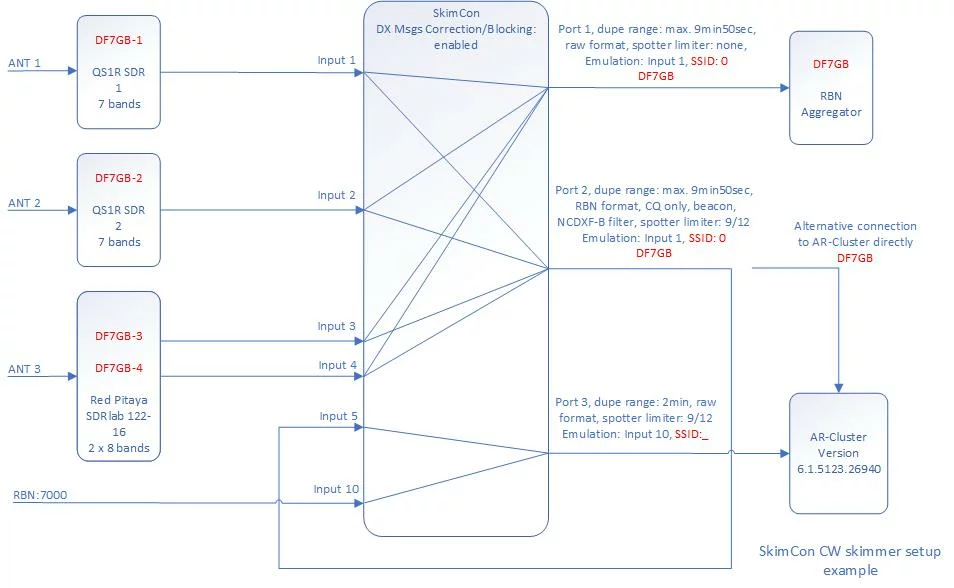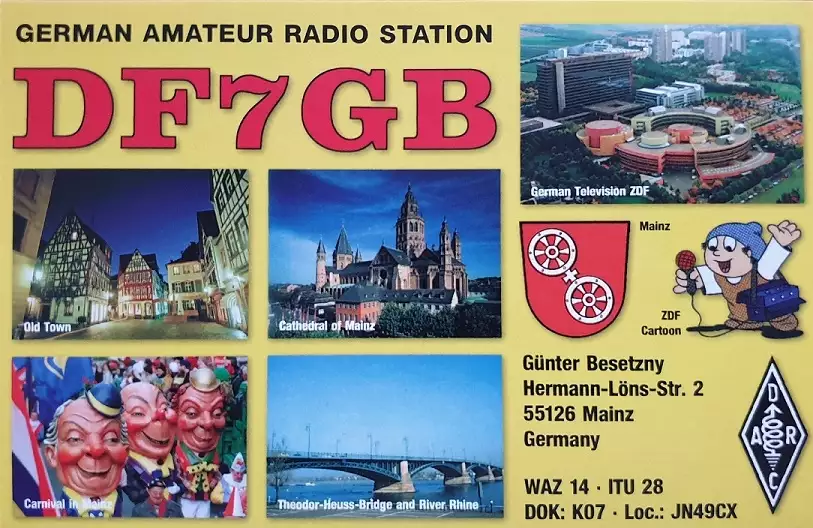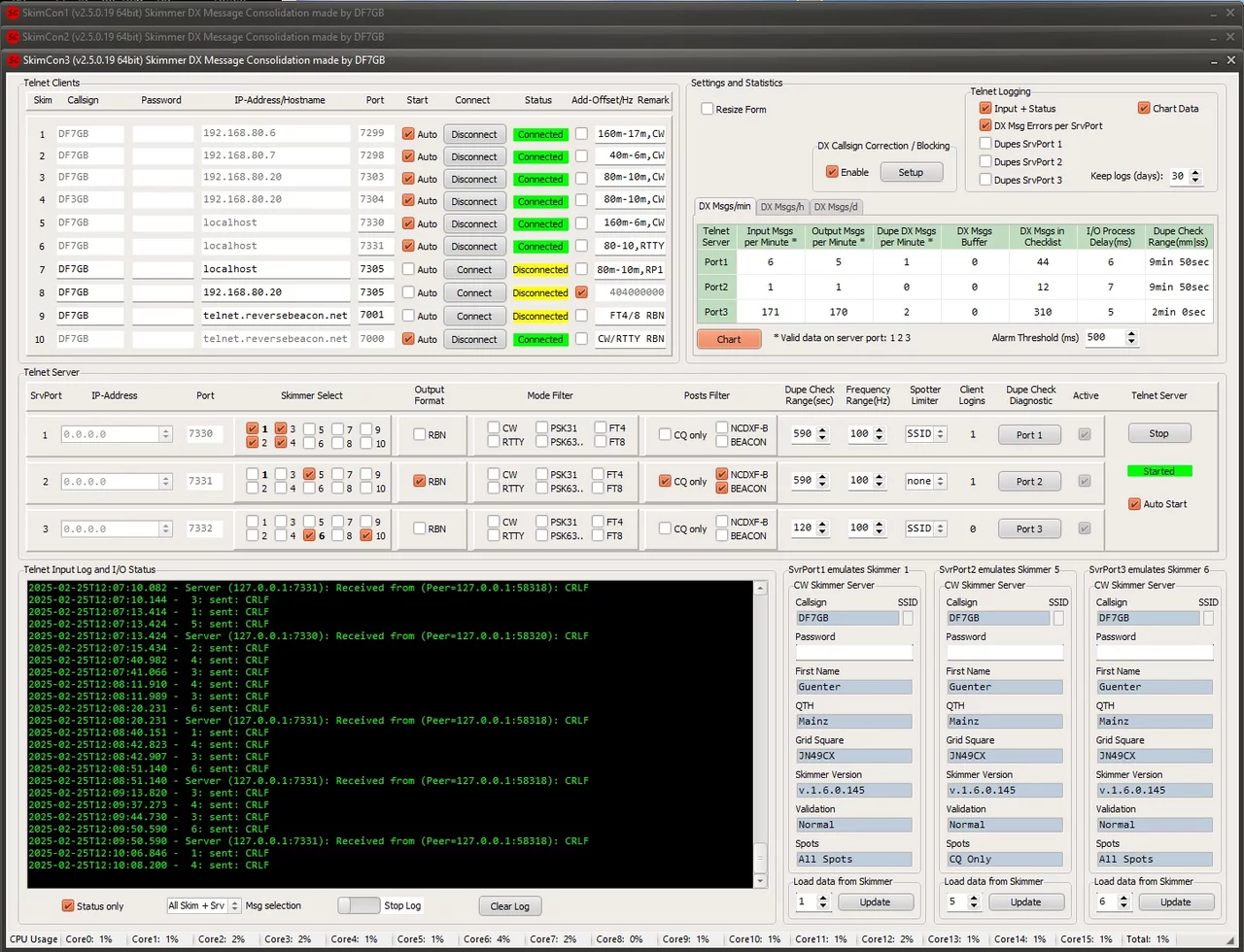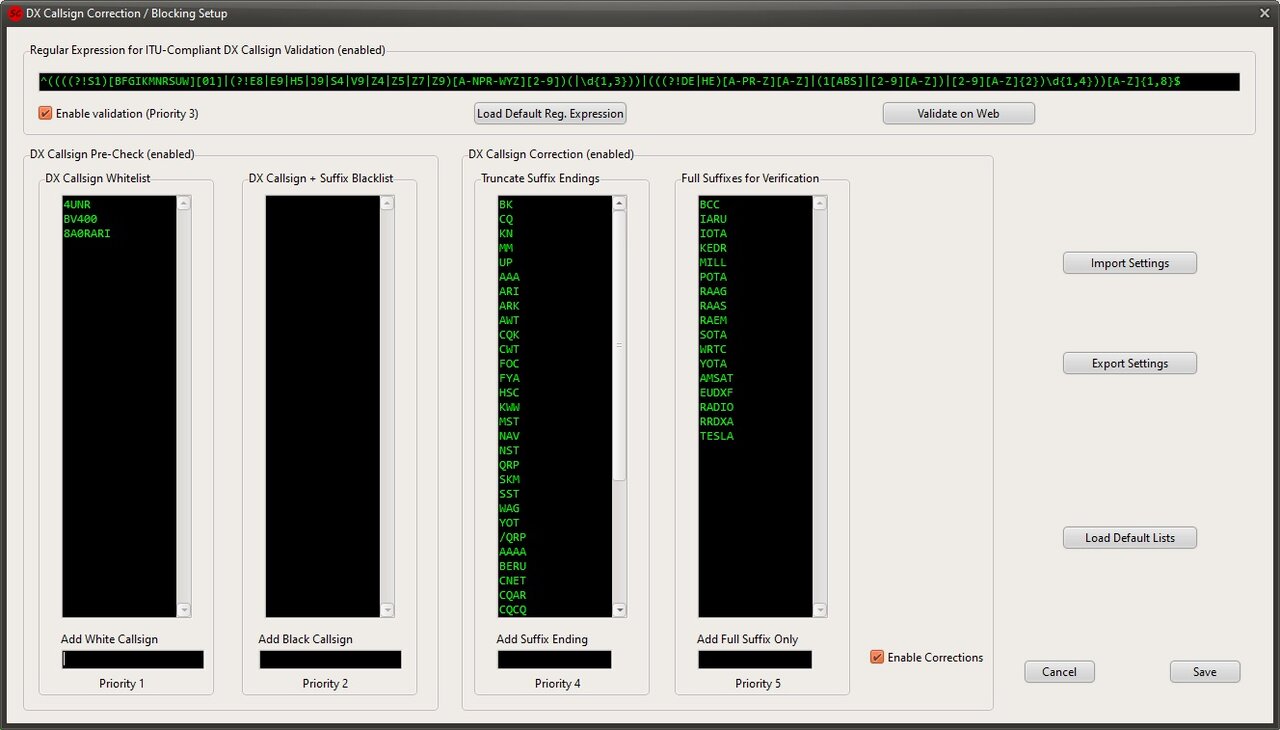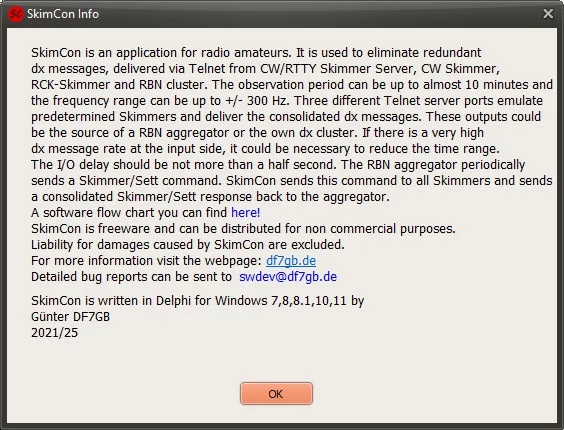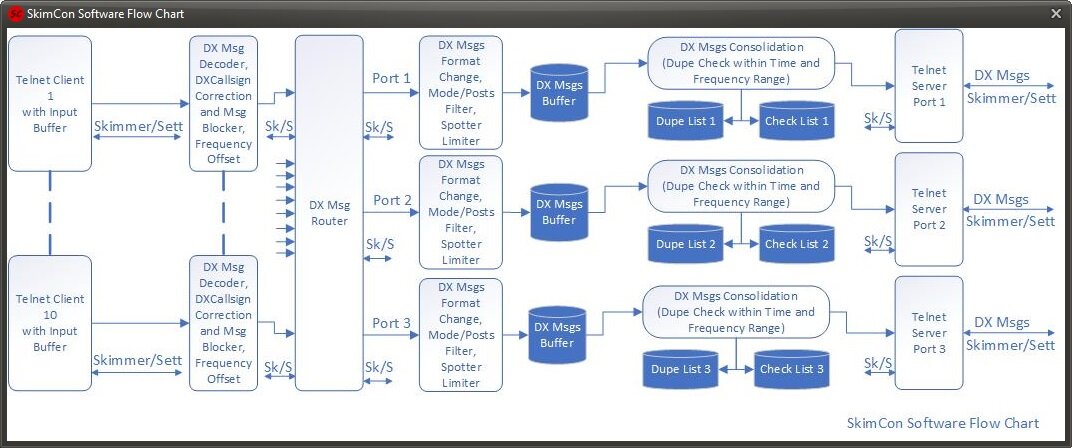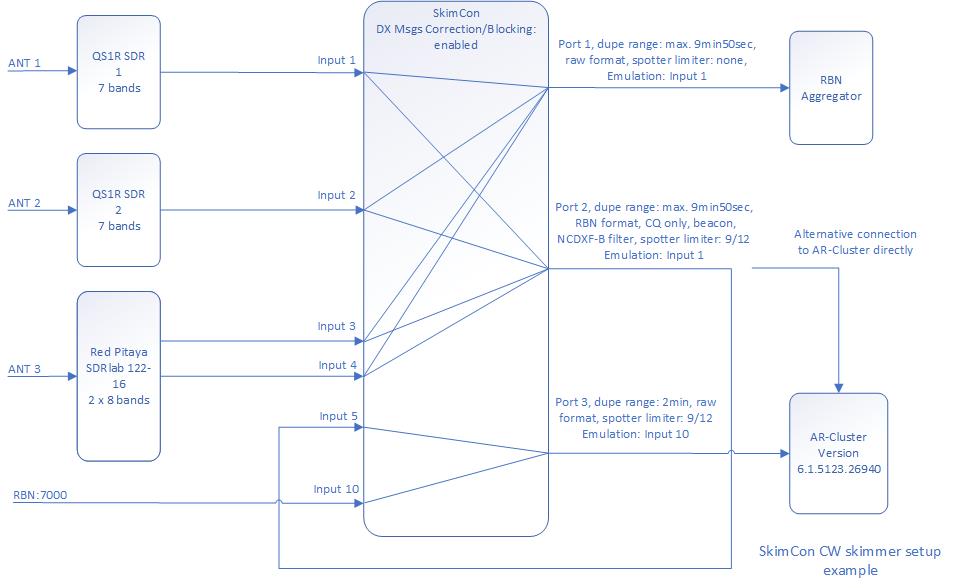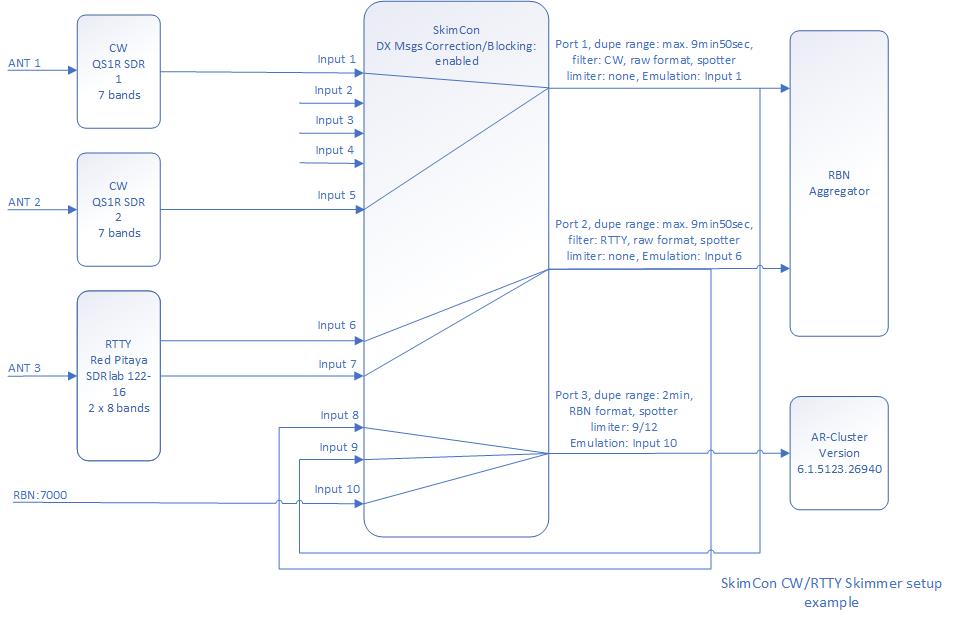SkimCon v2
SkimCon is an application for radio amateurs who provide a Reverse Beacon Network node. It is used to eliminate redundant dx messages, delivered via Telnet from CW/RTTY Skimmer Server, CW Skimmer, RCK-Skimmer and RBN cluster. The observation period can be up to 9 minutes 50 seconds and the frequency range can be up to +/- 300 Hz. Three different Telnet servers emulate predetermined Skimmer at the input side and deliver the consolidated dx messages. These outputs could be the source of an RBN aggregator or for your own dx cluster. If there is a very high dx message rate at the input side, it could be necessary to reduce the time range. This can happen if the data rate is more than 180000 dx messages per hour. The I/O delay should be not more than a half second. The RBN aggregator periodically sends a Skimmer/Sett command. SkimCon forwards this command to all skimmers on the inbound side and sends a consolidated Skimmer/Sett response back to the aggregator.
How can redundant dx messages arise. Overlapping skimmer bands can be used on two or more skimmer servers to higher the skimming output. Two different skimmers will often find different dx calls on the same band, especially when different antenna's are connected. A big amount of dx calls will be redundant. These can be eliminated with SkimCon in a certain time and frequency range. The redundant dx messages will not go to the Reverse Beacon Network. It helps to reduce the dx message load.
Feature List:
- Eliminate dupe dx messages delivered from connected Skimmer servers and/or RBN.
- Time range is up to 9 minutes 50 seconds and the frequency range is up to ±300 Hz. The frequency range setting could be helpful, if no GPSDO for the SDR's is available.
- The performance is on I7 8core machines up to 1.5 million dx messages per hour, if max. time range is used
- If a shorter time range is set, much more dx messages per hour can be handled.
- 10 Clients (e. g. Skimmer server) can be connected as sources and routed to three outputs.
- 3 Telnet server ports as outputs are available.
- Over 2100 client logins with full functionality of SkimCon was tested.
- Every Client can be routed to every server output.
- The output ports can emulate one of the input sources. The call signs in the skimmer settings must be the same.
- Skimmer/Sett command is transparent from Telnet server to every client. A connected Aggregator at the output will get a consolidated Skimmer/Sett response from all routed skimmers.
- RBN dx messages from port 7000 and 7001 can be also processed and can be used for own dx cluster server
- There are built in exclusive mode filters (CW, RTTY, PSK31, PSK63/PSK125, FT4, FT8). If one or more are checked, only these modes go through. If none are checked, all modes go through to the output.
- There are exclusive posts filter (CQ Only, NCDXF B, Beacon). These are working like the mode filters. If "CQ Only" is checked, that will be also considered in the Skimmer/Sett command, even if it is not checked on the skimmers itself.
- RBN format change at the Telnet server outputs. Can be used optionally for own dx cluster.
- If a spotter callsign is too long, it can be shortened to be fit for special AR Cluster versions. AR-Cluster V6.1.5123.26940 can handle max. 9 chars for Skimmer messages and 12 chars for normal dx messages, AR-Cluster V6.1.4782.17510 can handle max. 8 chars, respectively 10 chars. e.g. the callsign VR2FUN-77-# is not limited if "none" is chosen, if "9/12" is chosen it will result in VR2FUN-# and if "8/10" is chosen it will have the same result. In both cases the SSID will be omitted. Spotterlimiters are now configurable per port.
- With a built-in diagnostic tool it is possible to check how SkimCon is working. A search tool is provided in the check list and dupe list. If a call sign in the dupe list is clicked, it will show the time distance to the first appearance of this call sign.
- RCKskimmer: The spotter call size should not be longer than 8 characters, otherwise it overwrites the colon in the dx message. This problem if it occurs will be corrected by shorten the spotter call and inserting the colon again, automatically.
- Main form is resizable and fits on a 1920x1080 display. Scrollbar positions are recoverable.
- All operating elements are provided with hints.
- Configurable correction of busted callsigns including blacklist and whitelist. The callsign check is also done with a configurable regular expression. The regular expression is comparable with the patt3ch.lst rules, which are used from CW/RTTY-Skimmers. The difference is, this regular expression can filter illegal prefixes, e.g. SWL-callsigns with prefixes like DE or HE and ITU incompliant callsigns. Most of the time, illegal callsigns are busted callsigns that are later decoded correctly.
- The complete DX callsign correction/blocking setup can be both exported and imported.
- New dx message error log per server port, where callsign correction can be watched.
- Statistics expanded to I/O and dupe messages per hour and per day as well as dupe/input and corrected/input messages in percent.
- Now server login user callsign with SSID allowed.
- A spotter station callsign (SSID) can be added, changed or deleted. All sources with the same station callsign will receive the new SSID or no SSID (zero) if desired. Example: Client callsigns are DF7GB, DF7GB-1, DF7GB-2, etc. Server output 1 emulates client3, SSID is zero. All client SSIDs will be deleted but will still be in the same DX message consolidation process. The output callsign is DF7GB with no SSID. If a new SSID is desired, enter any SSID between 1 and 9 in the server port emulation SSID field. If no SSIDs are used, leave the SSID field blank.
- A chart has been added. It shows all the important data (input, output and dupe dx messages) during one day. It will be saved continuously. It is also possible to load several daily charts at once.
- Context help is provided
- SkimCon can be started with multiple instances in the same folder. Copy SkimCon.exe to the same folder and give it a different name, e.g. SkimCon-1 or SkimCon-DF7GB etc. But always start the new name with SkimCon. Remember to assign different Telnet server port numbers to all instances! This feature allows you to use more than 10 input clients and cascade multiple SkimCon instances.
- New option for Spotter Limiter. It generally allows to separate SSIDs from Skimmer spotter callsigns for a higher consolidation rate, especially for contest dx-cluster.

Installation:
Download and copy SkimCon.exe to a folder of your choice, e.g. “C:\SkimCon\” and then double-click. SkimCon runs on Windows 7 to 11. An Ini-file will be created after closing SkimCon. All settings will be saved in it. If Telnet Logging is checked, a new subfolder and up to 7 log files will be created. SkimCon can be installed on a Skimmer server itself or on any other PC which has network access to Skimmer servers. The minimized SkimCon.exe is running in the system tray. All Skimmers to be connected at SkimCon must use the same callsign in there settings. Otherwise no dupes will be eliminated.

